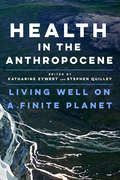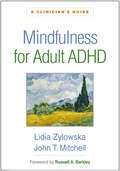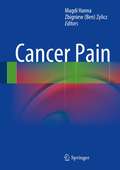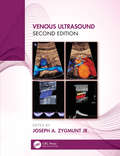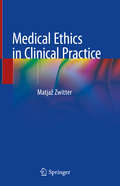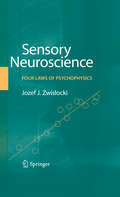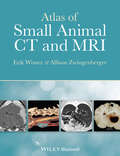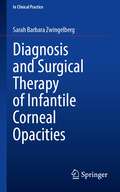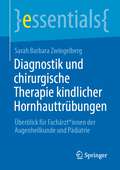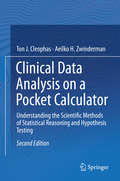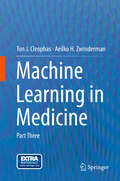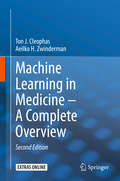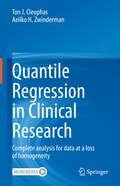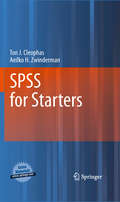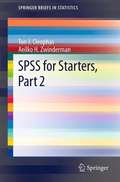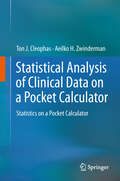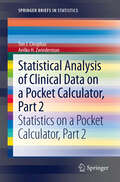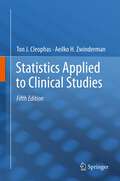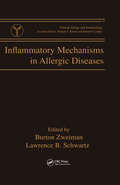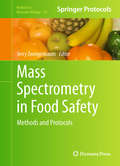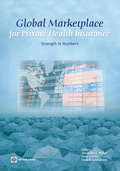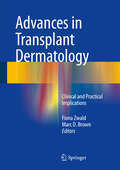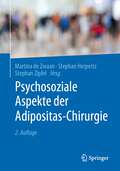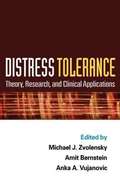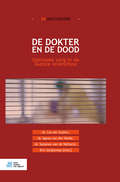- Table View
- List View
Health in the Anthropocene: Living Well on a Finite Planet (G - Reference,information And Interdisciplinary Subjects Ser.)
by Katharine Zywert Stephen QuilleyAdding to a growing body of knowledge about how the social-ecological dynamics of the Anthropocene affect human health, this collection presents strategies that both address core challenges, including climate change, stagnating economic growth, and rising socio-political instability, and offers novel frameworks for living well on a finite planet. Rather than directing readers to more sustainable ways to structure health systems, Health in the Anthropocene navigates the transition toward social-ecological systems that can support long-term human and environmental health, which requires broad shifts in thought and action, not only in formal health-related fields, but in our economic models, agriculture and food systems, ontologies, and ethics. Arguing that population health will largely be decided at the intersection of experimental social innovations and appropriate technologies, this volume calls readers to turn their attention toward social movements, practices, and ways of living that build resilience for an era of systemic change. Drawing on diverse disciplines and methodologies from fields including anthropology, ecological economics, sociology, and public health, Health in the Anthropocene maps out alternative pathways that have the potential to sustain human wellbeing and ecological integrity over the long term.
Mindfulness for Adult ADHD: A Clinician's Guide
by Lidia Zylowska John T. MitchellMindfulness has emerged as a valuable component of treatment for adults with attention-deficit/hyperactivity disorder (ADHD). This concise manual presents an evidence-based group intervention specifically tailored to the needs of this population. The Mindful Awareness Practices for ADHD (MAPs) program helps participants cultivate self-regulation of attention, emotions, and behavior; awareness of ADHD challenges; self-acceptance; and self-compassion. With a stepwise teaching approach and meditation periods that are shorter than in other mindfulness programs, MAPs is designed to optimize learning. Included are step-by-step instructions for conducting the eight sessions, scripts for guided meditations, 33 reproducible handouts, and &“Adaptation for Individual Therapy&” boxes. Purchasers get access to a companion website where they can download printable copies of the handouts and audio recordings of the guided practices.
Cancer Pain
by Zbigniew Zylicz Magdi HannaCancer Pain provides a comprehensive, practical guide to the management of pain in cancer patients. Beginning with a discussion of current issues in the control of cancer pain, the initial chapters provide a clear, concise explanation of cancer pain syndromes, an up-to-date understanding of the pathophysiological mechanism and recent developments in creating pre-clinical cancer pain models. The book offers the reader the wide and improved options for management of cancer pain in clinical practice including the use of opioid and non-opioid drugs and the role of non-pharmacological methods in pain control. Subsequent chapters address particular challenges in pain control, such as breakthrough pain, neuropathic cancer pain, as well as pain associated with cancer treatment which, until recently, has not been fully appreciated. Recent issues relating to new adverse side effects to chronic opioid medications such as hyperalgesia and neurotoxicity are explained, and best practice to reduce or avoid them is stated. The book also aims to aid in the overall educational need for young doctors as well as established primary care physicians by highlighting the available tools and the importance of early pain interventions in the overall cancer treatment strategy.
Venous Ultrasound
by Joseph A. ZygmuntVenous Ultrasound 2e is the essential text for anyone involved in the treatment of chronic venous disease. It provides specific information on ultrasound as it is applied to chronic insufficiency, including history, general techniques, examples of anatomy, and protocols for performing ultrasound on patients, and discussions on key aspects of interpretation of sonographic findings. Updated to include the outcome and impact of three recent studies, the ATTRACT trial, the EVRA study, and the VIDIO imaging trial. An entire chapter is dedicated to iliac venous and stent imaging for those interested in expanding practice based on the mentioned studies. Also included is specific protocol for imaging of the pelvic area with focus on the pelvic congestion and reflux affecting this anatomic area. This text demonstrates that as imaging techniques improve, so too will the understanding of venous pathologies increase and the burdens of their respective pathologies. Pelvic Congestion, iliofemoral and late stage disease can be interrogated with a non-invasive approach using the techniques included prior to interventional procedures. This fully updated new edition includes coverage of new ablation techniques which include non- thermal and non- tumescent therapies for venous insufficiency – these have unique ultrasound properties on what to see, look for and observe in intra and post- operative situations. Focusing on the fundamentals that every phlebologist needs to know, the color illustrations and numerous line drawings complement the text for a complete learning experience. Key features: Covers anatomy related to venous insufficiency and obstruction Protocols with step by step approaches for those new to certain exams Includes useful diagrams and images to aid understanding Thoroughly up to date, with all the latest information for those practicing venous therapies Venous Ultrasound 2e is valuable for sonographers and physicians alike; including phlebologists, general and vascular surgeons, physicians, radiologists, angiologists, interventional cardiologist, mid-levels, and nurses who work in this area.
Medical Ethics in Clinical Practice
by Matjaž ZwitterThis book discusses medicine from an ethical perspective, whereas books on medical ethics more commonly present ethics from a bio-medical standpoint. The book is divided into 23 chapters. The introductory chapters present some basic concepts of medical ethics, such as the relation between the legal system and ethics, ethical documents, ethical theories, and ethical analysis. The following chapters address issues of importance in all fields of medicine: respecting autonomy, communication, relations within a healthcare team, professional malpractice, limited resources, and the portrait of a physician. In turn, the third part of the book focuses on ethical aspects in a broad range of medical activities – preventive medicine, human reproduction, genetics, pediatrics, intensive care, palliative medicine, clinical research, unproven methods in diagnostics and treatment, and the role of physicians who aren’t directly responsible for patient care. The last part presents students’ seminars with case stories. The book offers a valuable resource for physicians of all specialties, students of medicine, professionals, and students from other fields devoted to human health, journalists, and general readers with an interest in medicine.
Sensory Neuroscience: Four Laws of Psychophysics
by Jozef J. ZwislockiSensory Neuroscience: Four Laws of Psychophysics organizes part of psychophysics -- a science of quantitative relationships between human sensations and the stimuli that evoke them. Although psychophysics belongs to sensory neuroscience, and is coupled to neurophysiology, it has also branched out to various specialized disciplines, including the disciplines of vision and hearing, ophthalmology, optometry, otology, and audiology. Due to this diversification and fragmentation, psychophysics has had an ad-hoc, phenomenological orientation. Besides Weber's law of differential sensitivity, and the still-controversial Stevens' power law, it has lacked a systematic grid of scientific laws. Sensory Neuroscience: Four Laws of Psychophysics provides valid unifying principles and systematic applications for this otherwise fragmented precursor of experimental psychology, and defines four multisensory relationships of substantial generality between sensations and the underlying stimulus variables. This book will be particularly useful to auditory researchers, experimental psychologists, and behavioral neuroscientists.
Atlas of Small Animal CT and MRI
by Allison Zwingenberger Erik WisnerAtlas of Small Animal CT & MRI is a highly illustrated diagnostic imaging guide to common clinical disorders of dogs and cats. Contains over 3,000 high quality CT, MRI and related diagnostic images Offers a unique approach emphasizing comparative imaging and pathologic correlation Focuses on important imaging features relevant to imaging diagnosis of disease in dogs and cats Written by internationally renowned experts in the field
Diagnosis and Surgical Therapy of Infantile Corneal Opacities (In Clinical Practice)
by Sarah Barbara ZwingelbergThe book provides a condensed overview of the diagnostics, genetics and current treatment options for congenital corneal opacities and dysgenesis of the anterior segment of the eye. Concise yet detailed presentation of the most important clinical congenital corneal opacities and their differential diagnoses including color illustrations are depicted throughout the book.Diagnosis and Surgical Therapy of Infantile Corneal Opacities includes up-to-date and scientifically reviewed therapy options for specific congenital corneal diseases. Ophthalmologists seeking a clear and concise congenital corneal disease reference guide will find this book to be an indispensable resource in their daily clinical practice.
Diagnostik und chirurgische Therapie kindlicher Hornhauttrübungen: Überblick für Fachärzt*innen der Augenheilkunde und Pädiatrie (essentials)
by Sarah Barbara ZwingelbergDie kindliche Hornhauttrübung gehört weltweit zu den Hauptursachen für Blindheit oder eine schwere Sehbehinderung bei Kindern. Die Ursachen sind hierbei vielfältig und komplex und besitzen ein enges therapeutisches Fenster aufgrund des erhöhten Risikos der Entwicklung einer Amblyopie. Dieses Essential gibt einen komprimierten Überblick zur Diagnostik, Klinik, Genetik und den aktuellen Behandlungsmöglichkeiten von angeborenen Hornhauttrübungen und Dysgenesie des vorderen Augenabschnitts.
Clinical Data Analysis on a Pocket Calculator: Understanding the Scientific Methods of Statistical Reasoning and Hypothesis Testing (SpringerBriefs in Statistics #0)
by Aeilko H. Zwinderman Ton J. CleophasInmedical and health care the scientific method is little used, and statisticalsoftware programs are experienced as black box programs producing lots ofp-values, but little answers to scientific questions. The pocket calculatoranalyses appears to be, particularly, appreciated, because they enable medicaland health professionals and students for the first time to understand thescientific methods of statistical reasoning and hypothesis testing. So much so,that it can start something like a new dimension in their professional world. Inaddition, anumber of statistical methods like power calculations and required sample sizecalculations can be performed more easily on a pocket calculator, than using asoftware program. Also, there are some specific advantages of thepocket calculator method. You better understand what you are doing. The pocketcalculator works faster, because far less steps have to be taken, averages canbe used. The current nonmathematical book is complementary to thenonmathematical "SPSS for Starters and 2nd Levelers" (Springer HeidelbergGermany 2015, from the same authors), and can very well be used as its dailycompanion.
Machine Learning in Medicine
by Aeilko H. Zwinderman Ton J. CleophasMachine learning is a novel discipline concerned with the analysis of large and multiple variables data. It involves computationally intensive methods, like factor analysis, cluster analysis, and discriminant analysis. It is currently mainly the domain of computer scientists, and is already commonly used in social sciences, marketing research, operational research and applied sciences. It is virtually unused in clinical research. This is probably due to the traditional belief of clinicians in clinical trials where multiple variables are equally balanced by the randomization process and are not further taken into account. In contrast, modern computer data files often involve hundreds of variables like genes and other laboratory values, and computationally intensive methods are required. This book was written as a hand-hold presentation accessible to clinicians, and as a must-read publication for those new to the methods.
Machine Learning in Medicine – A Complete Overview
by Aeilko H. Zwinderman Ton J. CleophasAdequate health and health care is no longer possible without proper data supervision from modern machine learning methodologies like cluster models, neural networks, and other data mining methodologies. The current book is the first publication of a complete overview of machine learning methodologies for the medical and health sector, and it was written as a training companion, and as a must-read, not only for physicians and students, but also for any one involved in the process and progress of health and health care.In this second edition the authors have removed the textual errors from the first edition. Also, the improved tables from the first edition, have been replaced with the original tables from the software programs as applied. This is, because, unlike the former, the latter were without error, and readers were better familiar with them.The main purpose of the first edition was, to provide stepwise analyses of the novel methods from data examples, but background information and clinical relevance information may have been somewhat lacking. Therefore, each chapter now contains a section entitled "Background Information".Machine learning may be more informative, and may provide better sensitivity of testing than traditional analytic methods may do. In the second edition a place has been given for the use of machine learning not only to the analysis of observational clinical data, but also to that of controlled clinical trials.Unlike the first edition, the second edition has drawings in full color providing a helpful extra dimension to the data analysis.Several machine learning methodologies not yet covered in the first edition, but increasingly important today, have been included in this updated edition, for example, negative binomial and Poisson regressions, sparse canonical analysis, Firth's bias adjusted logistic analysis, omics research, eigenvalues and eigenvectors.
Quantile Regression in Clinical Research: Complete analysis for data at a loss of homogeneity
by Aeilko H. Zwinderman Ton J. CleophasQuantile regression is an approach to data at a loss of homogeneity, for example (1) data with outliers, (2) skewed data like corona - deaths data, (3) data with inconstant variability, (4) big data. In clinical research many examples can be given like circadian phenomena, and diseases where spreading may be dependent on subsets with frailty, low weight, low hygiene, and many forms of lack of healthiness. Stratified analyses is the laborious and rather explorative way of analysis, but quantile analysis is a more fruitful, faster and completer alternative for the purpose. Considering all of this, we are on the verge of a revolution in data analysis. The current edition is the first textbook and tutorial of quantile regressions for medical and healthcare students as well as recollection/update bench, and help desk for professionals. Each chapter can be studied as a standalone and covers one of the many fields in the fast growing world of quantile regressions. Step by step analyses of over 20 data files stored at extras.springer.com are included for self-assessment. We should add that the authors are well qualified in their field. Professor Zwinderman is past-president of the International Society of Biostatistics (2012-2015) and Professor Cleophas is past-president of the American College of Angiology(2000-2002). From their expertise they should be able to make adequate selections of modern quantile regression methods for the benefit of physicians, students, and investigators.
SPSS for Starters
by Aeilko H. Zwinderman Ton J. CleophasThis small book contains all statistical tests that are relevant for starters on SPSS. Each test is explained using a data example from clinical practice, including every step in SPSS and the main tables of results with an accompanying text with interpretations of the results and hints convenient for data reporting, i.e., scientific clinical articles and poster presentations.. In order to facilitate the use of this cookbook the data files of the examples are made available by the publisher on the Internet. For investigators who wish to perform their own data analyses from the very start the book can be used as a step-by-step guideline. They can enter their separate data or enter their entire data file, e.g., from Excel, simply by opening an Excel file in SPSS. SPSS statistical software is a user-friendly statistical software with many help and tutor pages. However, for the novices on SPSS an even more basic approach is welcome. The book is meant for this very purpose, and can be used without the help of a teacher. The authors are well-aware that this cookbook contains a minimal amount of text and a maximal technical details, but we believe that this property will not refrain students from mastering the SPSS software systematic, and that, instead, it will even be a help to that aim. Yet, we recommend that it be used together with the textbook "Statistics Applied to Clinical Trials" by Cleophas et al, 4th Edition, 2009, Springer Dordrecht.
SPSS for Starters, Part 2
by Aeilko H. Zwinderman Ton J. CleophasThe first part of this title contained all statistical tests that are relevant for starters on SPSS, and included standard parametric and non-parametric tests for continuous and binary variables, regression methods, trend tests, and reliability and validity assessments of diagnostic tests. The current part 2 of this title reviews multistep methods, multivariate models, assessments of missing data, performance of diagnostic tests, meta-regression, Poisson regression, confounding and interaction, and survival analyses using log tests and segmented time-dependent Cox regression. Methods for assessing non linear models, data seasonality, distribution free methods, including Monte Carlo methods and artificial intelligence, and robust tests are also covered. Each method of testing is explained using a data example from clinical practice,including every step in SPSS, and a text with interpretations of the results and hints convenient for data reporting. In order to facilitate the use of this cookbook the data files of the examples is made available by the editor through extras.springer.com. Both part 1 and 2 of this title contain a minima amount of text and maximal technical details, but we believe that this property will not refrain students from mastering the SPSS software systematics, and that, instead, it will be a help to that aim. Yet, we recommend that it will used together with the textbook "Statistics Applied to Clinical Trials" (5th edition, Springer, Dordrecht 2012) and the e-books "Statistics on a Pocket Calculator Part 1 and 2 (Springer, Dordrecht, 2011 and 2012) from the same authors.
Statistical Analysis of Clinical Data on a Pocket Calculator
by Aeilko H. Zwinderman Ton J. CleophasThe core principles of statistical analysis are too easily forgotten in today's world of powerful computers and time-saving algorithms. This step-by-step primer takes researchers who lack the confidence to conduct their own analyses right back to basics, allowing them to scrutinize their own data through a series of rapidly executed reckonings on a simple pocket calculator. A range of easily navigable tutorials facilitate the reader's assimilation of the techniques, while a separate chapter on next generation Flash prepares them for future developments in the field. This practical volume also contains tips on how to deny hackers access to Flash internet sites. An ideal companion to the author's co-authored works on statistical analysis for Springer such as Statistics Applied to Clinical Trials, this monograph will help researchers understand the processes involved in interpreting clinical data, as well as being a necessary prerequisite to mastering more advanced statistical techniques. The principles of statistical analysis are easily forgotten in today's world of time-saving algorithms. This step-by-step primer takes researchers back to basics, enabling them to examine their own data through a series of sums on a simple pocket calculator.
Statistical Analysis of Clinical Data on a Pocket Calculator, Part 2
by Aeilko H. Zwinderman Ton J. CleophasThe first part of this title contained all statistical tests relevant to starting clinical investigations, and included tests for continuous and binary data, power, sample size, multiple testing, variability, confounding, interaction, and reliability. The current part 2 of this title reviews methods for handling missing data, manipulated data, multiple confounders, predictions beyond observation, uncertainty of diagnostic tests, and the problems of outliers. Also robust tests, non-linear modeling , goodness of fit testing, Bhatacharya models, item response modeling, superiority testing, variability testing, binary partitioning for CART (classification and regression tree) methods, meta-analysis, and simple tests for incident analysis and unexpected observations at the workplace and reviewed. Each test method is reported together with (1) a data example from practice, (2) all steps to be taken using a scientific pocket calculator, and (3) the main results and their interpretation. Although several of the described methods can also be carried out with the help of statistical software, the latter procedure will be considerably slower. Both part 1 and 2 of this title consist of a minimum of text and this will enhance the process of mastering the methods. Yet the authors recommend that for a better understanding of the test procedures the books be used together with the same authors' textbook "Statistics Applied to Clinical Studies" 5th edition edited 2012, by Springer Dordrecht Netherlands. More complex data files like data files with multiple treatment modalities or multiple predictor variables can not be analyzed with a pocket calculator. We recommend that the small books "SPSS for starters", Part 1 and 2 (Springer, Dordrecht, 2010, and 2012) from the same authors be used as a complementary help for the readers' benefit.
Statistics Applied to Clinical Studies
by Aeilko H. Zwinderman Ton J. CleophasThanks to the omnipresent computer, current statistics can include data files of many thousands of values, and can perform any exploratory analysis in less than seconds. This development, however fascinating, generally does not lead to simple results. We should not forget that clinical studies are, mostly, for confirming prior hypotheses based on sound arguments, and the simplest tests provide the best power and are adequate for such studies. In the past few years the authors of this 5th edition, as teachers and research supervisors in academic and top-clinical facilities, have been able to closely observe the latest developments in the field of clinical data analysis, and they have been able to assess their performance. In this 5th edition the 47 chapters of the previous edition have been maintained and upgraded according to the current state of the art, and 20 novel chapters have been added after strict selection of the most valuable and promising novel methods. The novel methods are explained using practical examples and step-by-step analyses readily accessible for non-mathematicians. All of the novel chapters have been internationally published by the authors in peer-reviewed journal, including the American Journal of Therapeutics, the European Journal of Clinical Investigation, The International journal of Clinical Pharmacology and therapeutics, and other journals, and permission is granted by all of them to use this material in the current book. We should add that the authors are well-qualified in their fields of knowledge. Professor Zwinderman is president-elect of the International Society of Biostatistics, and Professor Cleophas is past-president of the American College of Angiology. From their expertise they should be able to make adequate selections of modern methods for clinical data analysis for the benefit of physicians, students, and investigators. The authors, although from a different discipline, one clinician and one statistician, have been working and publishing together for over 10 years, and their research of statistical methodology can be characterized as a continued effort to demonstrate that statistics is not mathematics but rather a discipline at the interface of biology and mathematics. They firmly believe that any reader can benefit from this clinical approach to statistical data analysis.
Inflammatory Mechanisms in Allergic Diseases (Clinical Allergy And Immunology Ser. #Vol. 16)
by Burton Zweiman Lawrence B. SchwartzContains patterns of allergic reactivity for disorders such as asthma, atopic dermatitis, urticaria, and anaphylaxis. Written by leading experts in the field, Inflammatory Mechanisms in Allergic Diseases covers non-anaphylactic drug disorders; synthesis and formation of IgE antibodies; new treatments using allergenic peptides, immunostimulatory oligonucleotides, and pharmacogenomics;recent advances targeting effector mechanisms; hypersensitivity reactions to drugs and more! With over 3100 references, tables, drawings, and micrographs, Inflammatory Mechanisms in Allergic Diseases is an essential reference for allergists, pulmonologists, immunologists, dermatologists, ophthalmologists, otolaryngologists, internists, pediatricians, family practitioners, and medical students in these disciplines.
Mass Spectrometry in Food Safety
by Jerry ZweigenbaumAs a key component of human survival, a safe and sufficient food supply is essential for a healthy and productive population throughout the world, so assurance that the food supply is clean and free of harmful substances is a global concern. In Mass Spectrometry in Food Safety: Methods and Protocols, experts in the field provide context to the subject through reviews of regulations in various countries, the current state-of-the art, and specific, detailed scientific methods being employed today. The volume thoroughly covers the key areas in food safety, such as detection of low level chemical residues, pesticide analysis aided by chromatographic techniques, and the revealing of mycotoxins and chemical contaminants from packaging materials. Written in the highly successful Methods in Molecular BiologyTM series format, method chapters contain introductions to their respective topics, lists of the necessary materials and reagents, step-by-step, readily reproducible laboratory protocols, and tips on troubleshooting and avoiding known pitfalls. Pertinent and cutting-edge, Mass Spectrometry in Food Safety: Methods and Protocols serves researchers with both understanding and appreciation for the contribution of mass spectrometry and its vital application to food testing and food safety.
Global Marketplace for Private Health Insurance: Strength in Numbers
by Peter Zweifel Onno P. Schellekens Alexander S. PrekerFinancial protection against the cost of illness and inclusion of vulnerable groups - will require better mobilization and use of private means. Private voluntary health insurance already plays an important role in mobilizing additional resources to the health sector and protecting against the catastrophic cost of illness in some countries. This review explores the context under which private voluntary health insurance could contribute to an improvement in the sustainability of the health sector and financial protection in other countries.
Advances in Transplant Dermatology: Clinical and Practical Implications
by Fiona Zwald Marc D. BrownThis book provides an informative update on scientific advances relating to transplant dermatology that may be applicable to clinical practice. Commentary is provided on the emerging role of viruses in transplant dermatology, the management of skin disease secondary to transplant medication, sunscreen use in transplant recipients, the role of revision of immunosuppression, and advances in photodynamic therapy. The latest staging and management criteria for high-risk squamous cell carcinoma and the implications for clinical practice are then analyzed. Finally, the management of other cutaneous malignancies is discussed, covering malignant melanoma, Merkel cell carcinoma, and rarer tumors that also behave aggressively and require special consideration in solid organ transplant patients. Each particular advance is addressed in an individual chapter by leaders in the field. The book both expands current knowledge and complements previous textbooks on the subject.
Psychosoziale Aspekte der Adipositas-Chirurgie
by Martina De Zwaan Stephan Herpertz Stephan ZipfelDas Buch soll einen ersten Überblick über die psychotherapeutische Begleitung von Patienten vor und nach bariatrischen chirurgischen Eingriffen geben. Es richtet sich an die therapeutischen Teams, die mit Adipositaspatienten vor und nach der Operation arbeiten, soll aber auch Chirurgen für das Thema sensibilisieren. Durch die zunehmende Zahl an entsprechenden Operationen steigt die Notwendigkeit, diese Patienten während des gesamten Prozesses zu begleiten.
Distress Tolerance
by Michael Zvolensky Amit BernsteinThis state-of-the-art volume synthesizes the growing body of knowledge on the role of distress tolerance the ability to withstand aversive internal states such as negative emotions and uncomfortable bodily sensations in psychopathology. Prominent contributors describe how the construct has been conceptualized and measured and examine its links to a range of specific psychological disorders. Exemplary treatment approaches that target distress tolerance are reviewed. Featuring compelling clinical illustrations, the book highlights implications of the research for better understanding how psychological problems develop and how to assess and treat them effectively.
De dokter en de dood: Optimale zorg in de laatste levensfase
by Lia Zuylen Agnes Heide Suzanne Vathorst Eric GeijtemanIedereen kent het ongenuanceerde verhaal: dokters zijn opgeleid en gemotiveerd om mensen beter te maken. Maar betekent dat dan automatisch ook dat zulke professionals hun focus verliezen bij pati#65533;nten met een infauste prognose? Dokters kunnen zich juist ook in de laatste levensfase buitengewoon verdienstelijk maken. Een complicatie daarbij is wel dat de geneeskunde-opleiding tot op de huidige dag tekort schiet in het overdragen van kennis over (be)handelen zonder curatieve intentie. Mogelijk dat prioriteiten in een overvolle doktersdag daarom wel eens in het voordeel uitvallen van pati#65533;nten met een redelijke prognose. Dit boek biedt een praktisch houvast voor artsen en andere zorgprofessionals om optimale omstandigheden te cre#65533;ren voor pati#65533;nten in tijdnood. 47 Vakgenoten bewijzen in dit boek dat optimale zorg haalbaar is in de hectische praktijk van alledag. Elk hoofdstuk start met een herkenbare casus. Dan volgt een breder getrokken beschouwing over de geschetste problematiek. Een paragraaf met praktische conclusies completeert het geheel steeds. Aldus komen - soms hoofdbrekende - thema's aan bod: Wat is 'op tijd' vertellen? Hoe gaat een arts om met een terminale pati#65533;nt die hoop houdt? Kunnen alle betrokken behandelaars alle relevante gegevens kennen? Is palliatieve sedatie in sommige gevallen geen sluitroute voor euthanasie? waar ligt de grens tussen goed behandelen en te lang doorbehandelen? Maar ook het contact met de familie komt aan de orde. Evenals de wenselijke zorg om de zorgverlener zelf, die immers per definitie vaak moet omgaan met het lijden van pati#65533;nten en hun omgeving. "Er is volop discussie gaande over de vraag of mensen die 'klaar' zijn met leven geholpen zouden kunnen worden binnen de euthanasiewet. De uitkomst van die discussie kan de grenzen verschuiven, mede afhankelijk van wat de beroepsgroep van artsen tot haar taak en domein rekent. "
